ON BOARD
BAGLIETTO'S
40M ATTITUDE
What started as a speculation project, turned into one of Baglietto's most successful semi-custom series to date. Sam Fortescue steps on board the first DOM 133 hull.
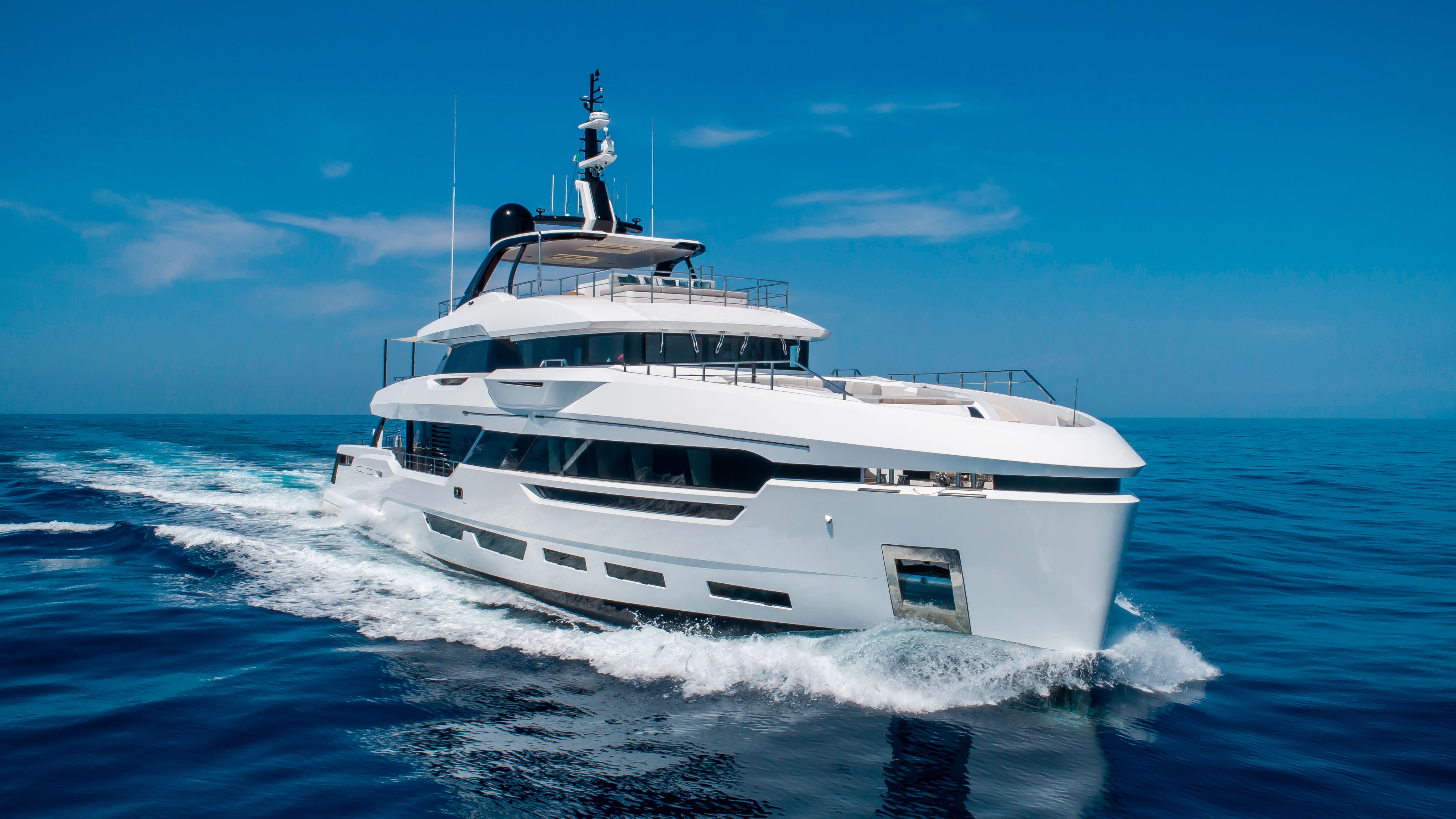
Yachts are often styled as villas on the sea, but there can be few that fit the bill so completely. Baglietto’s latest semi-custom success story is called the DOM 133, and even the name is taken from the Latin word domus, meaning home. It was started on spec by the Italian builder with a brief both inside and out that was strikingly architectural. Pull back the curtains, however, or look behind the sofas and you find a different yacht.
Under its immaculate outer skin, the DOM 133 offers hybrid options and an ocean-trotting design that mark it out as far more than “just another” 40-metre yacht. And in strict contrast to the model name, Baglietto pursued a clear strategy of sourcing design input “out-of-house” to broaden its horizons.
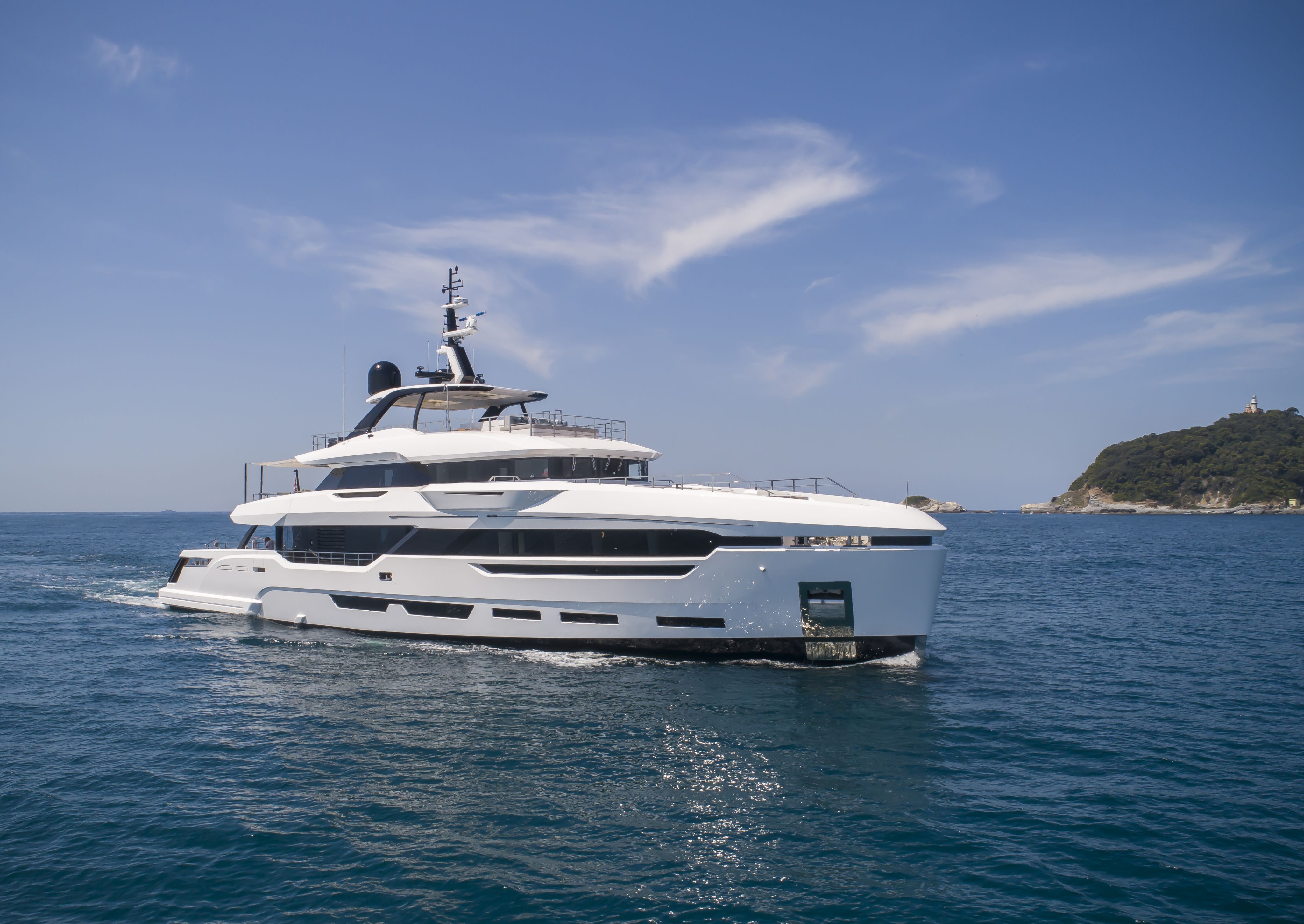
“The starting point was to design a spacious yet appealing yacht with a strong personality,” explains Baglietto’s chief commercial officer Fabio Ermetto. “The idea to build a ‘home away from home’ lies at the core of this series of mid-size, aluminium cruisers modelled around the functional and lifestyle needs of modern yacht owners.”
It is a starting point that has moved Baglietto away from long-term collaborator Francesco Paszkowski, who has designed the exterior look of its three previous lines. All fitting into the 40- to 62-metre segment, these yachts have sold successfully over the last year and run from heavy displacement cruisers to more nimble aluminium planing yachts.
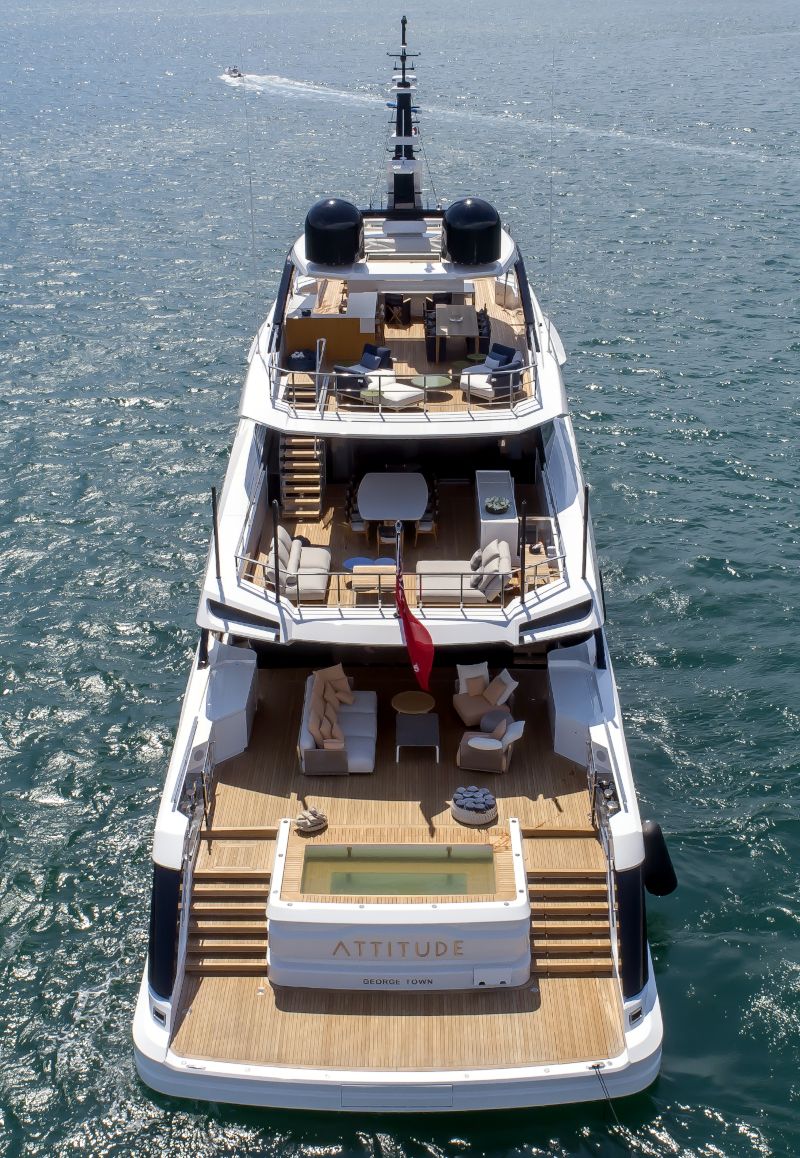
GIULIANO SARGENTINIThe goal was to create an edgy, fresh and sculptural boat
GIULIANO SARGENTINIThe goal was to create an edgy, fresh and sculptural boat
Stefano Vafiadis has instead been brought in to create a distinctly different look. “The very first brief was very intriguing,” he says. “The goal was to create an edgy, fresh and sculptural boat but, at the same time, with great internal volumes.” By contrast to the other Bagliettos, the DOM 133 has a near-plumb bow, a clean black-and-white profile and angular, more challenging lines. And with its taller superstructure, it offers 411 gross tonnes of internal space.
“The exterior design has all the influences of my greatest passions: car design and architecture,” continues Vafiadis. “They are all translated into the shape of a 40-metre yacht, keeping many stylistic details to have the same ‘tension’ and dynamic feeling that you would find in the best expressions of the automotive industry.”
Another major area of focus for Vafiadis and the Baglietto team was the aft end of the boat. The beach club has been arranged on two levels, occupying the aft six metres of the main deck with its pool, as well as a dedicated bathing platform below. “The pool and the aft lounge is intended like a staircase that ends in the sea, creating a strong connection with the marine environment,” explains Vafiadis.
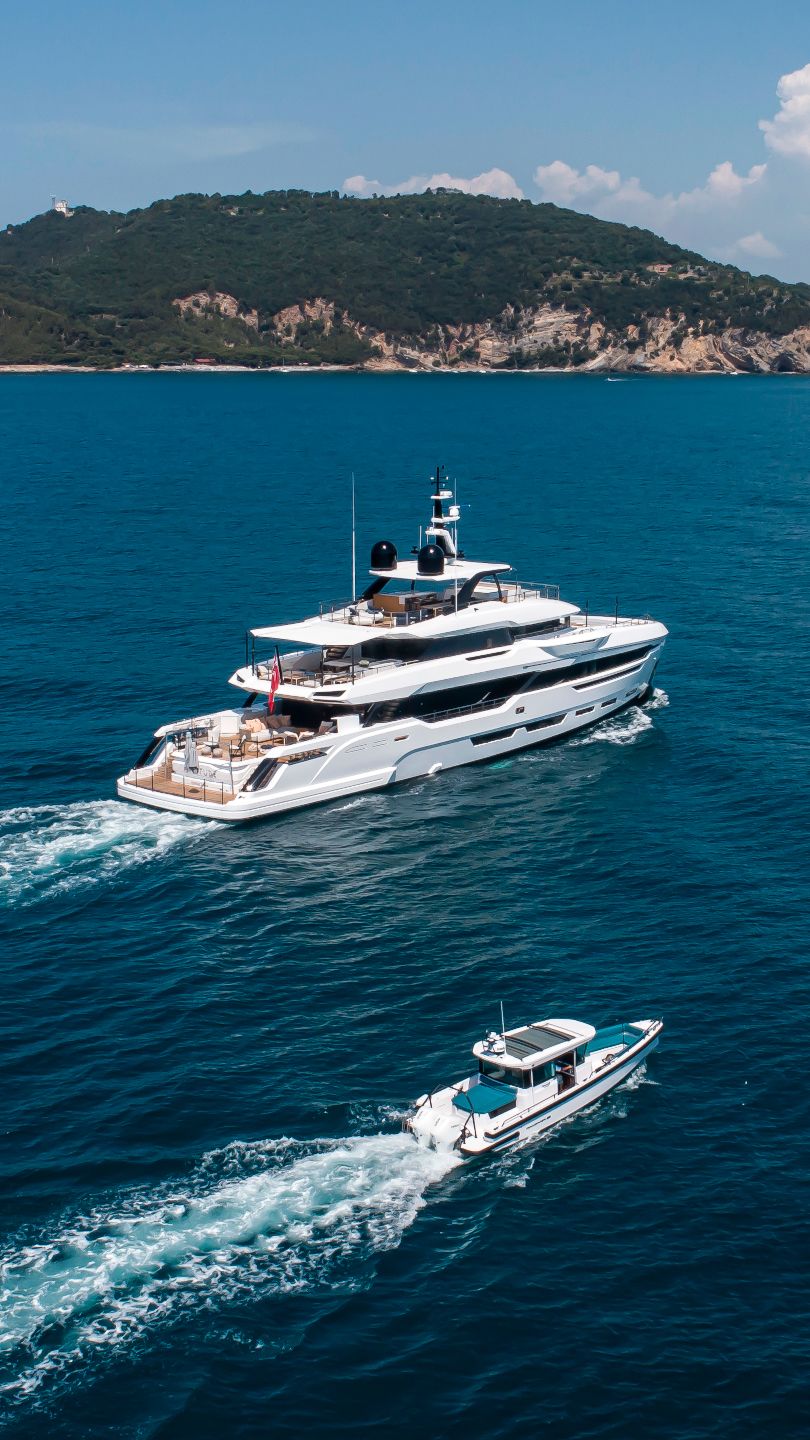
GIULIANO SARGENTINIThough Attitude features a large side-opening garage for a 5.5-metre tender, the owner opted for the Axopar 28 as a chase boat.
GIULIANO SARGENTINIThough Attitude features a large side-opening garage for a 5.5-metre tender, the owner opted for the Axopar 28 as a chase boat.
They hit a novel solution to optimise aft deck space by giving the pool a lifting bottom, and therefore two distinct purposes. It can serve as a dance floor or extension of the main deck when required, or lower to reveal a three-metre by two-metre pool with integrated seating. The double-life theme continues with the steps down to the bathing platform.
Those automotive details include two air exchange grilles on the upper deck with a parametric pattern that resembles modern car radiators. Vafiadis was also influenced by the spoiler of a sports car when drawing the aft edge of the upper and fly decks. “But the inspiration from the automotive sector lay not only in the sports niche but also in the aggressive lines combined with big volumes of the latest SUVs, that are really the new battlefield for designers,” he adds.
“The starting point was to design a spacious yet appealing yacht with a strong personality,” explains Baglietto’s chief commercial officer Fabio Ermetto. “The idea to build a ‘home away from home’ lies at the core of this series of mid-size, aluminium cruisers modelled around the functional and lifestyle needs of modern yacht owners.”
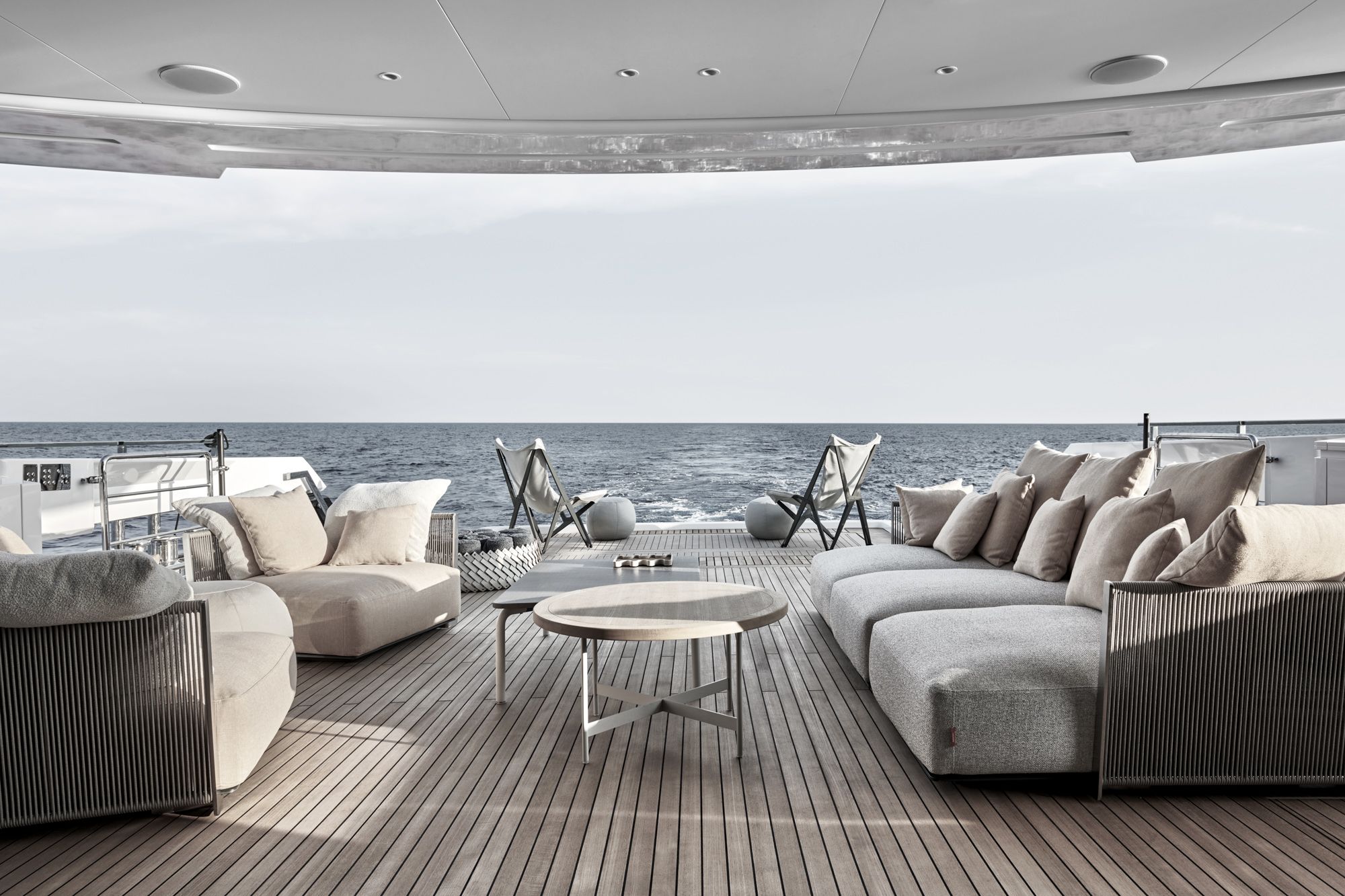
LEO TORRI The DOM133 model taps into the trend for open-air beach clubs with a tiered main deck aft and an infinity swimming pool with a high-low floor.
LEO TORRI The DOM133 model taps into the trend for open-air beach clubs with a tiered main deck aft and an infinity swimming pool with a high-low floor.
Though the staircase on the port side looks identical to that on the starboard side, it is in fact a disguised gangway. The steps swing up and swivel until they present a level surface which can then be manoeuvred hydraulically to the quayside. And as if that weren’t James Bond enough, the transformer is built into a kind of “drawer” in the bathing platform, completely invisible when not in use.
“The concept of the two-level beach club stems from the idea of giving guests the same space in any situation, whether at anchor or in port,” says Ermetto. “It is multi-purpose. Unlike beaches with opening hatches that do not allow use in port, the stern with a swimming pool with a liftable bottom allows it to be used in any situation.”
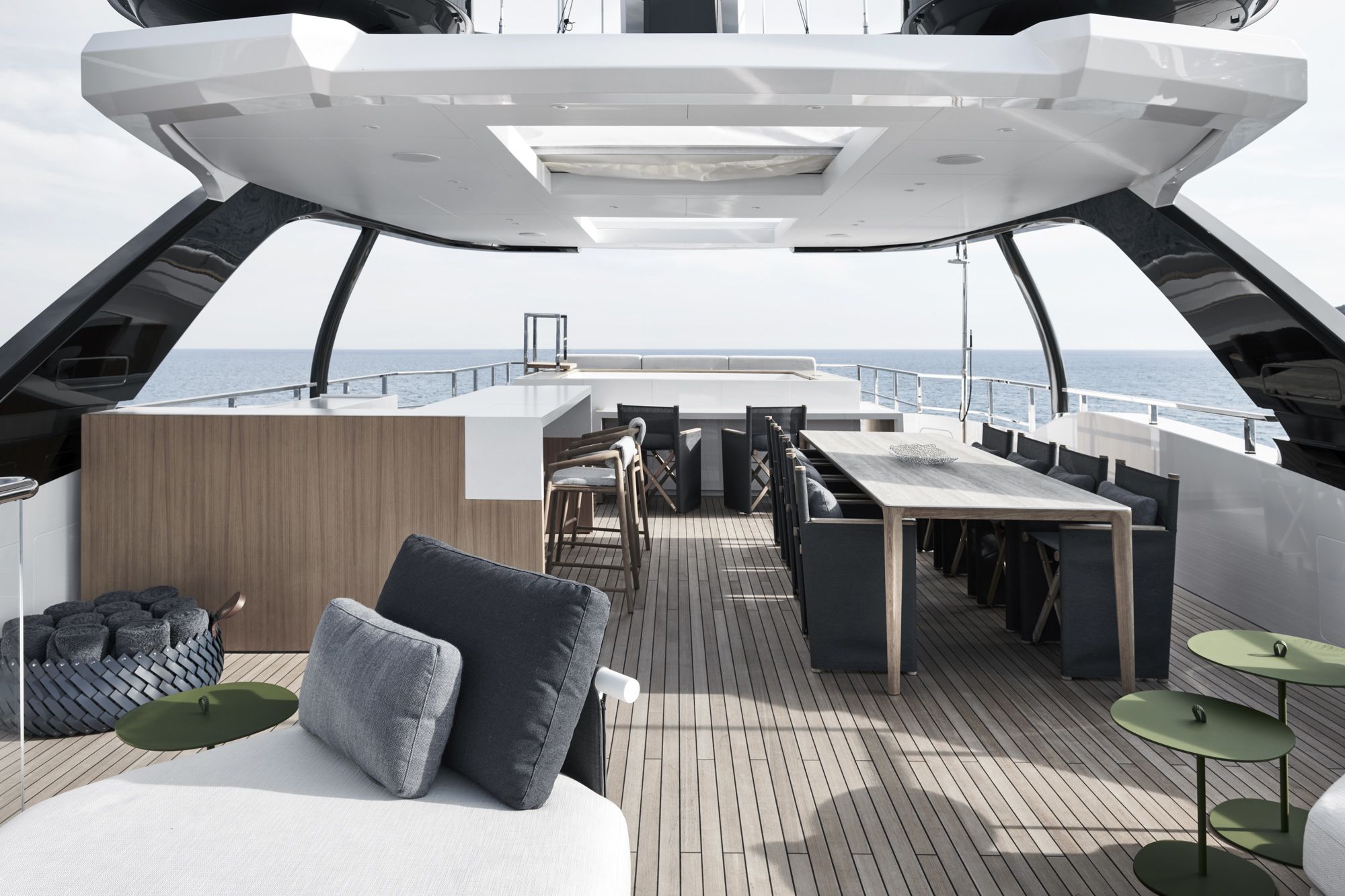

LEO TORRIThe sundeck features spa pool and teak surround, sunbeds for relaxing, and a family-sized table for dining
LEO TORRIThe sundeck features spa pool and teak surround, sunbeds for relaxing, and a family-sized table for dining
Exterior space has been carefully maximised on this boat and equally carefully apportioned to avoid doubling up on key functions. The main deck aft features cosy seating and lounging, while the upper deck is laid out for elegant al fresco dining for up to 10 and as a sun-worshipping station.
An epic sundeck covering 75 square metres combines all three functions in a more relaxed fashion. Up here there are sun beds forward, a spa pool with teak surround, room to lounge on geometrically shaped sunpads and a family table and bar. There’s even a foredeck cockpit with sofas, sunpads and low tables, giving guests another relaxing option.
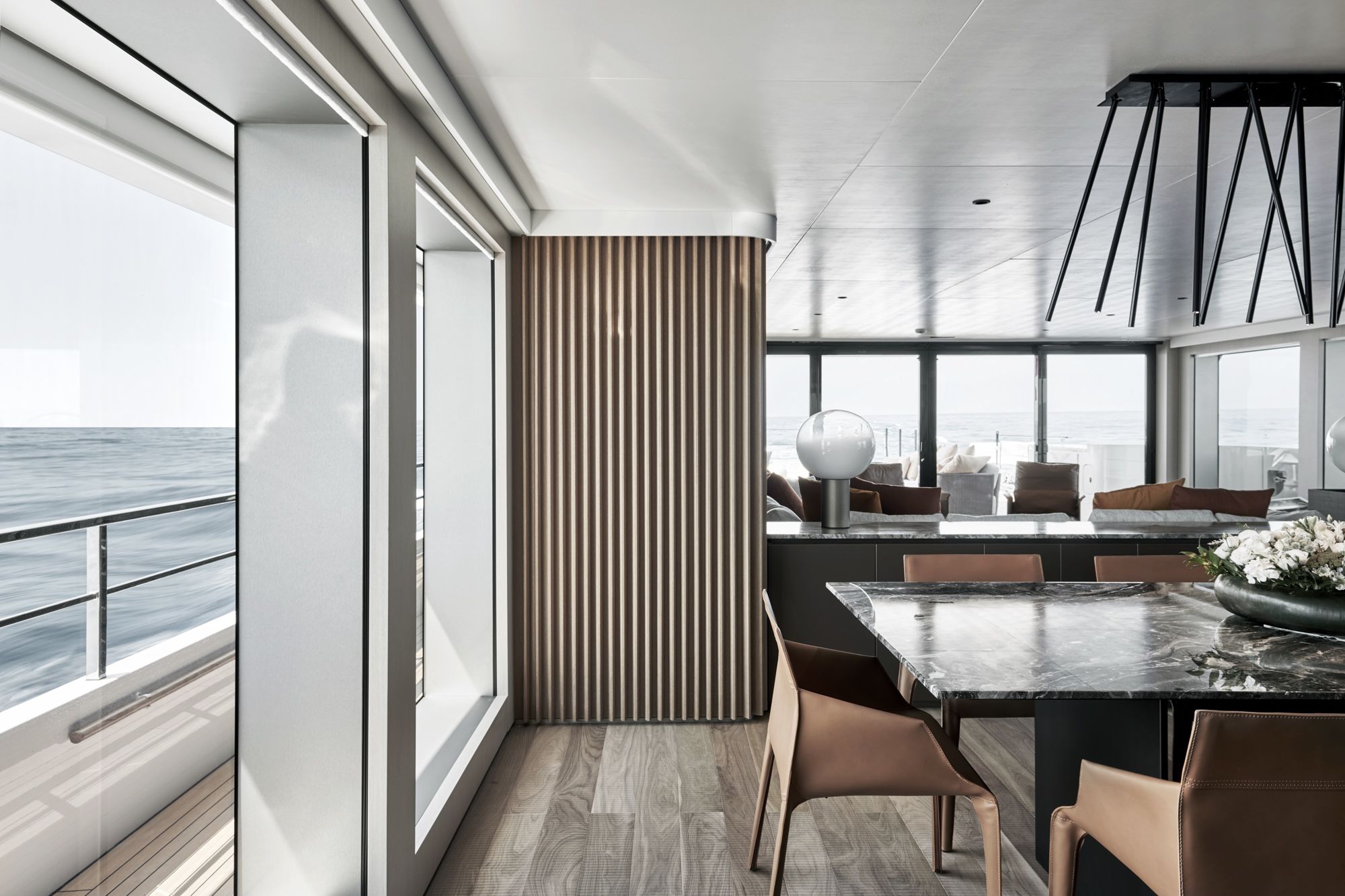
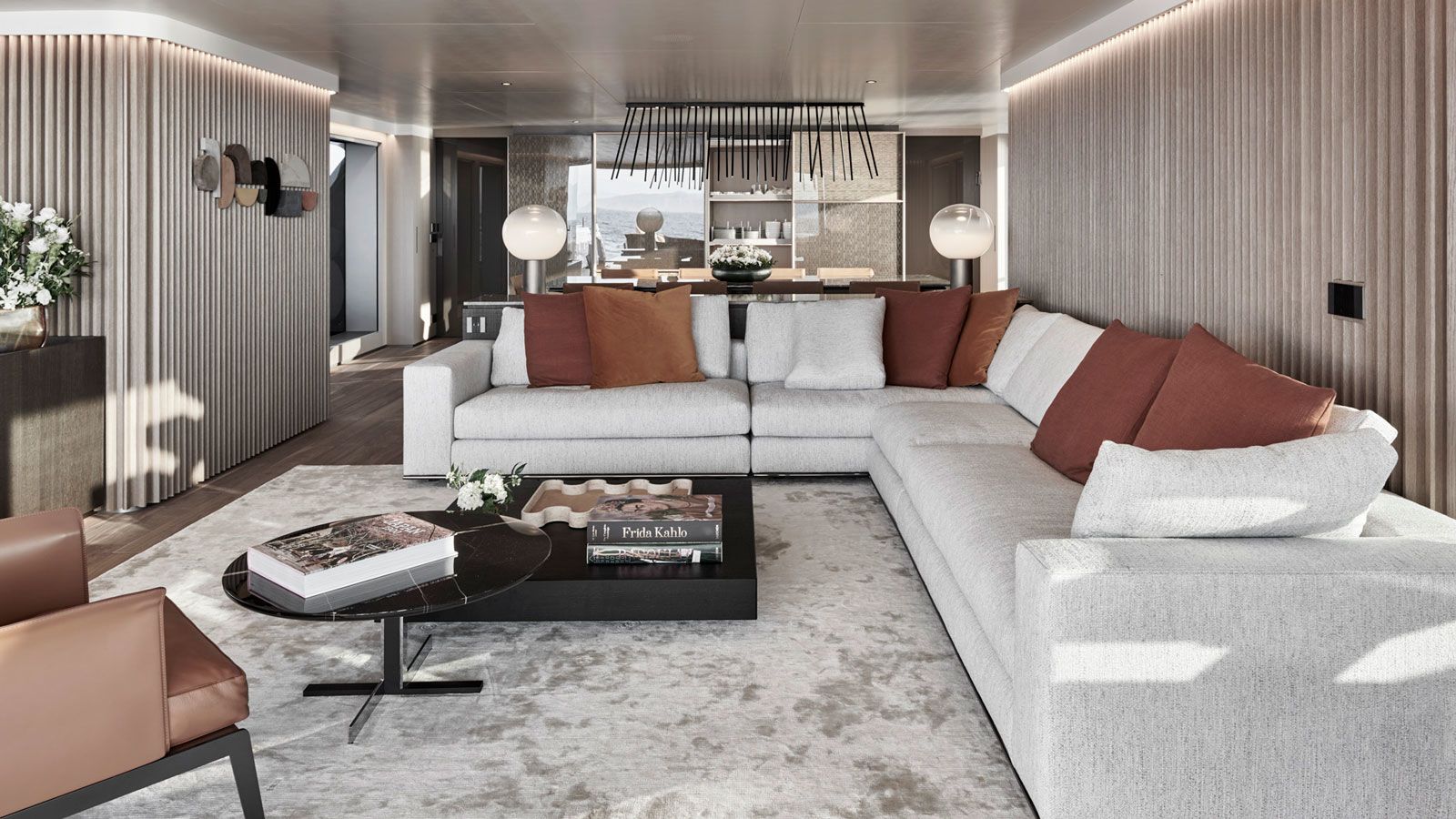
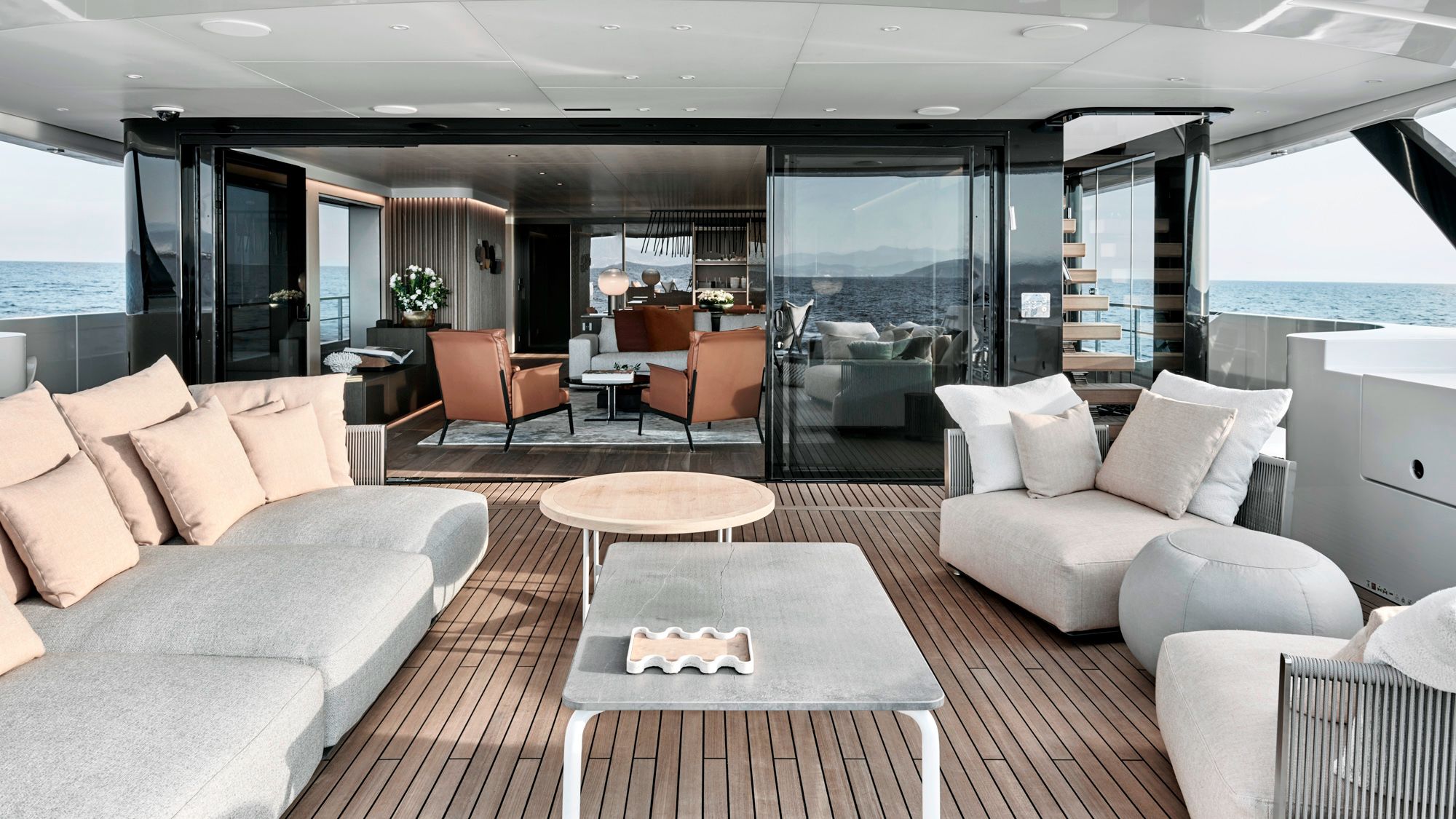

LEO TORRI
LEO TORRI

LEO TORRI
LEO TORRI

LEO TORRI
LEO TORRI
The main deck aft features cosy seating and lounging, while the upper deck is laid out for elegant al fresco dining
All the furniture is free-standing from Italian brands such as Minotti, Flexform and Paola Lenti, and can therefore be changed or specced as required. With a further seven boats sold blind, there are bound to be some differing visions from other owners here. But it seems that Baglietto’s standard layout suited the first owner’s programme very well. He named his boat Attitude.
“He didn’t make any change on the external design because he fell in love with the yacht from the first time,” says Ermetto when I quiz him about the difficulties of starting a project without a buyer.
Amazingly, Attitude’s interior was a similar story, with the owner coming in right at the end of the process. Baglietto put out feelers for new contacts in this area too, and connected with the Mexican interior designer Ezequiel Farca. Farca himself is no stranger to yacht design, having styled a series of 35- to 45-metre Benettis and completed concepts for yachts up to 60 metres.
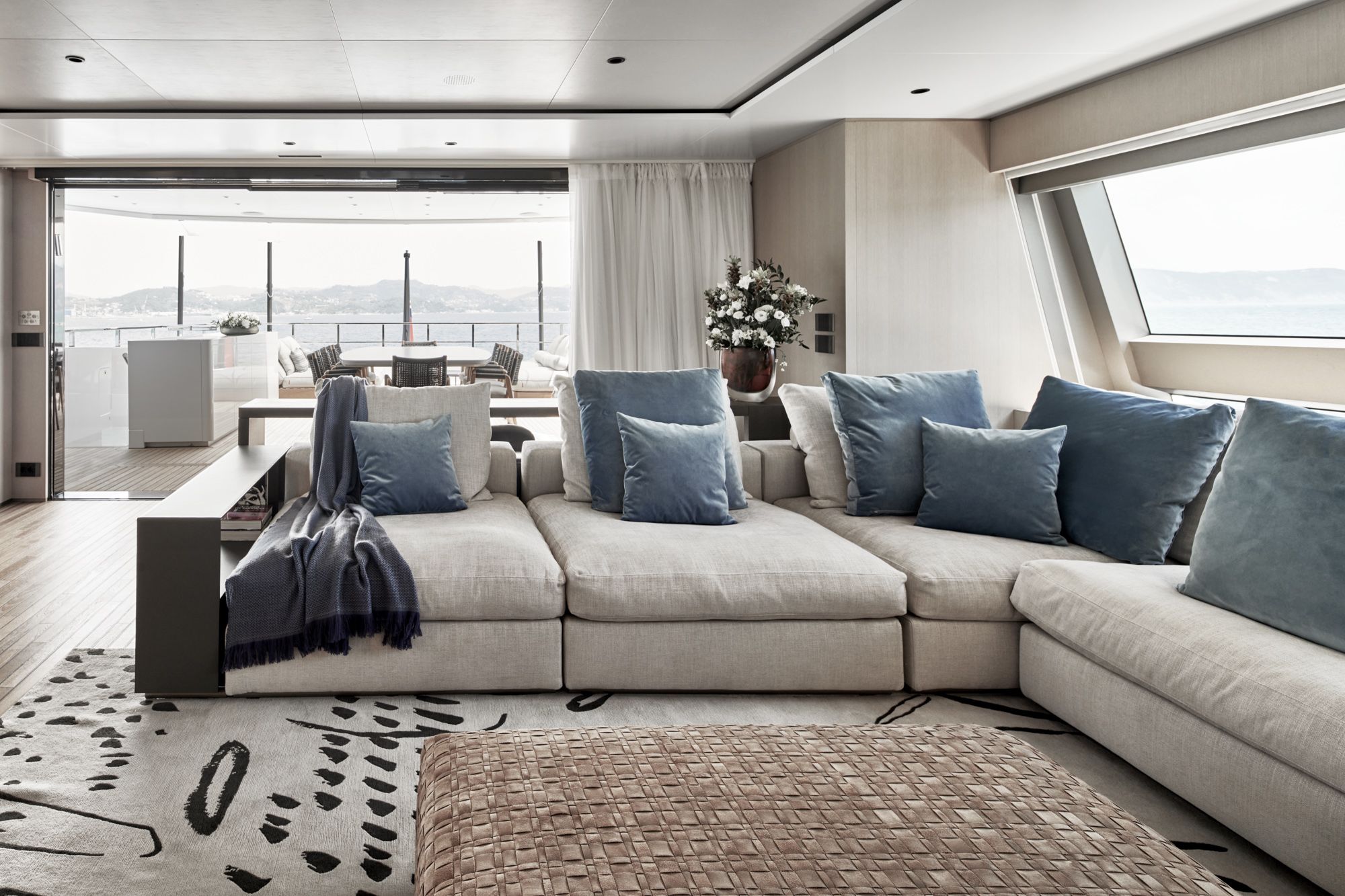
LEO TORRI
LEO TORRI
“The essence of the project – the art of living, has always been our passion,” says Farca. “It is no secret that with the pandemic everyone rediscovered the way we live and moreover how we co-live, thus giving a new meaning and appreciation for space, comfort and family time.
“This became one of our main guidelines: Attitude would have to be able to host a family which intends to spend longer-than-usual periods of time on board, around different types of destinations and with a family that will change throughout time – children will grow up, new types of guests will be welcomed on board and new interests will develop.”
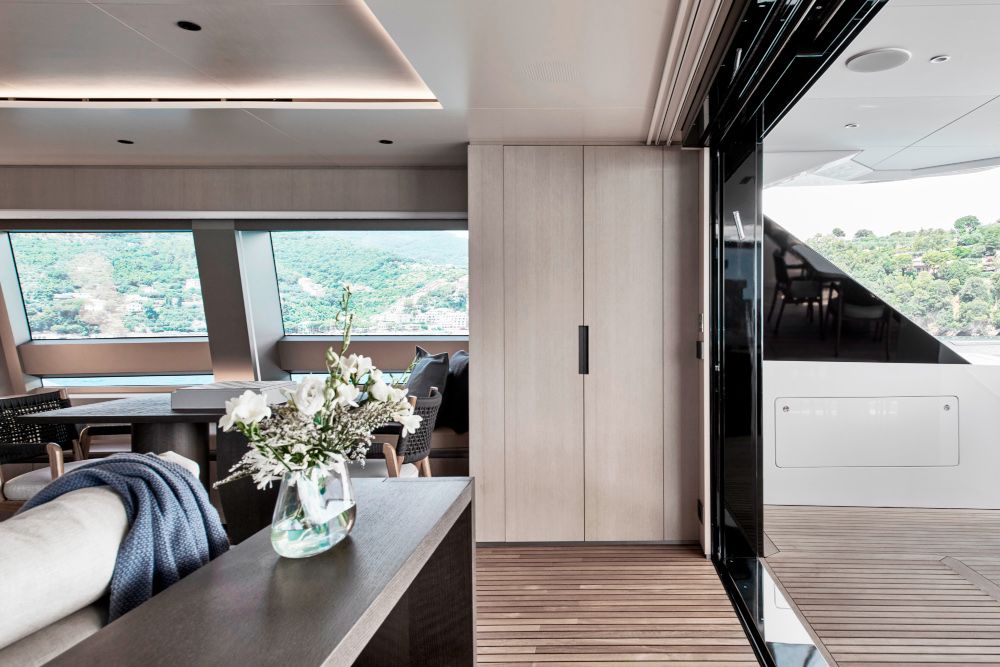
LEO TORRIThe use of neutral tones create a relaxing and peaceful atmosphere
LEO TORRIThe use of neutral tones create a relaxing and peaceful atmosphere
This brief led the design team to select materials that would feel as comfortable and liveable today as they should in a decade’s time. So they have avoided particularly flashy or “wow” features that risk aging badly, and focused on a friendly, relaxing palette. Naturally enough, wood features prominently. From the oak panelling around the floor-to-ceiling windows in the main saloon to the textured oak boards underfoot, it has a calming effect.
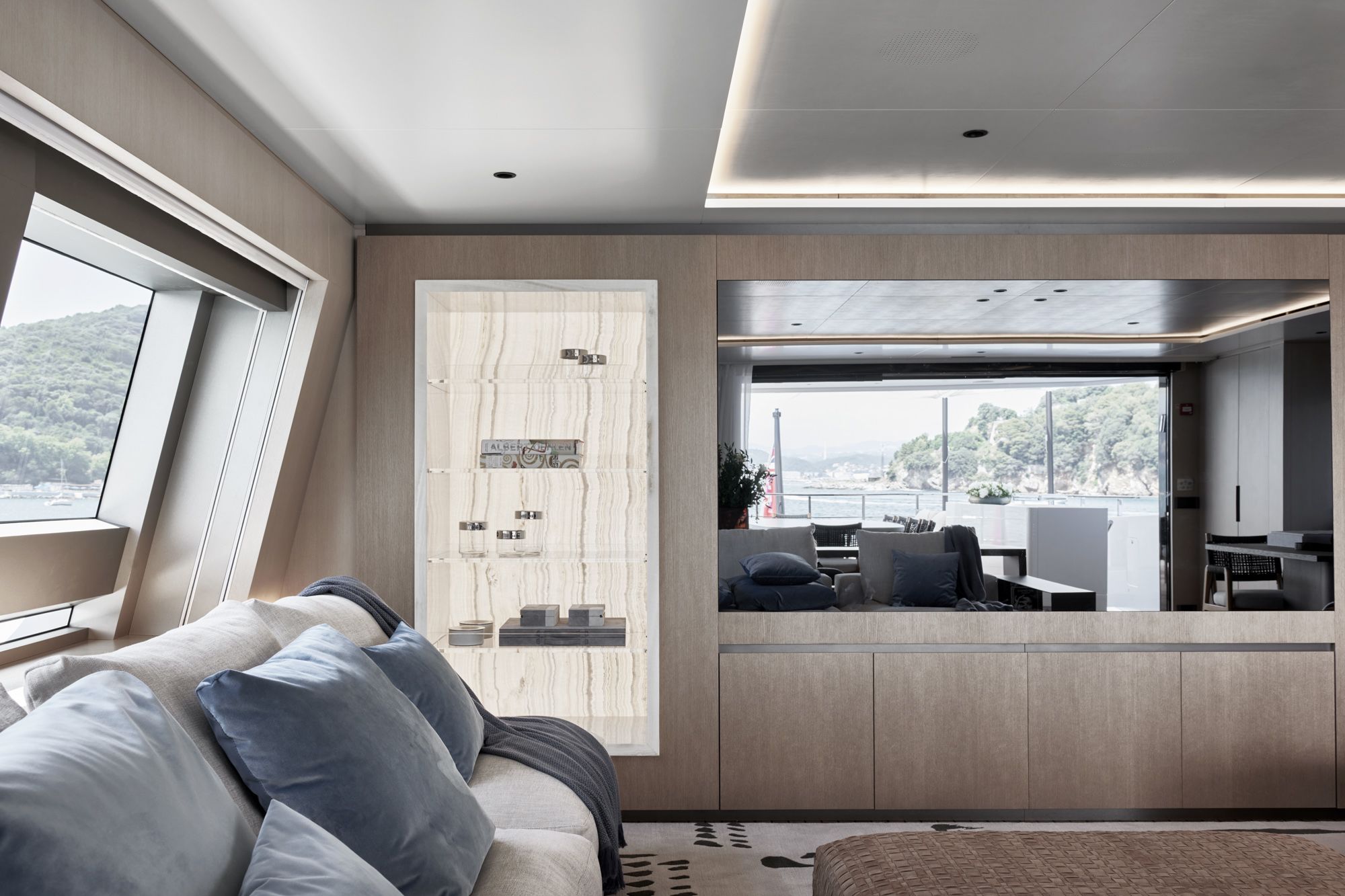
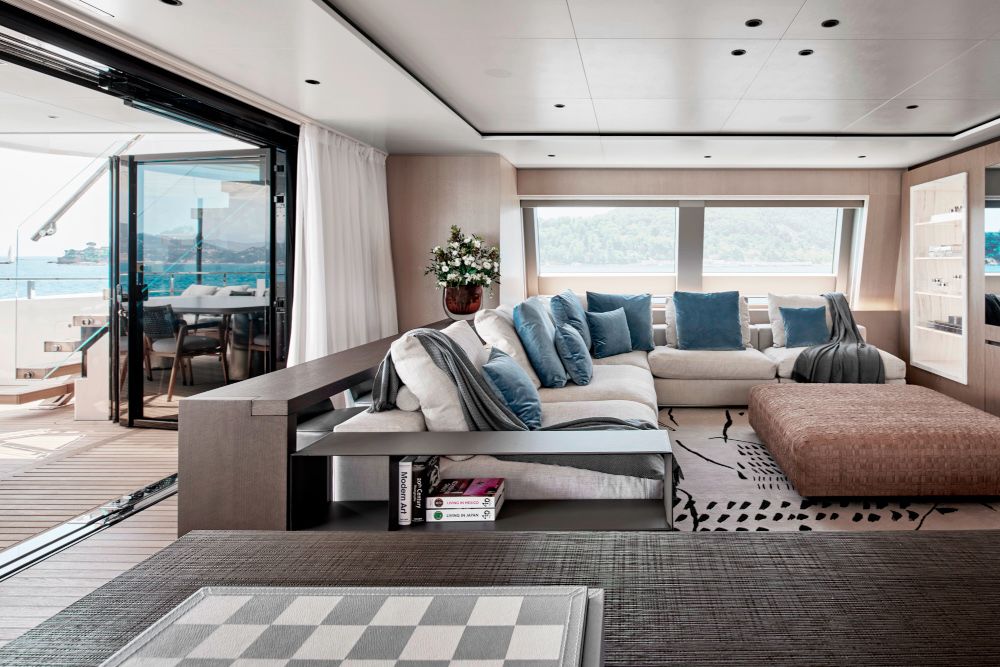

LEO TORRI
LEO TORRI

LEO TORRI
LEO TORRI
The doors can be completely slid aside and stacked up under the portside exterior stairs to create a full-width opening
The upper deck saloon uses wooden parquet flooring to create another effect. Carefully matching the spacing and caulking of the exterior teak work helps to create a sense of continuity when the doors are slid back. “As a result, a single beautiful in-out space is created where several activities can be carried out while enjoying the company of a large group of people in the same space,” says Farca.
This is less the case in the main saloon. The aft doors do slide wide open, but the disposition of the furniture insists there is no continuity with the cockpit. Sleek leather armchairs turn their backs, choosing to focus instead on the sofas and coffee tables inside.
Rich tan leather and gleaming black-grey emperador marble surfaces combine to give the space a slightly cooler, clubby vibe – something that is underscored by the presence of ribbed wooden panelling on the walls, gleaming metal mesh cabinets and a hedgehog of a custom Viabizzuno chandelier made of bristling black aluminium tubes. This hangs over a huge marble table that enjoys sweeping sea views through floor-to-ceiling glass and cut away bulwarks.
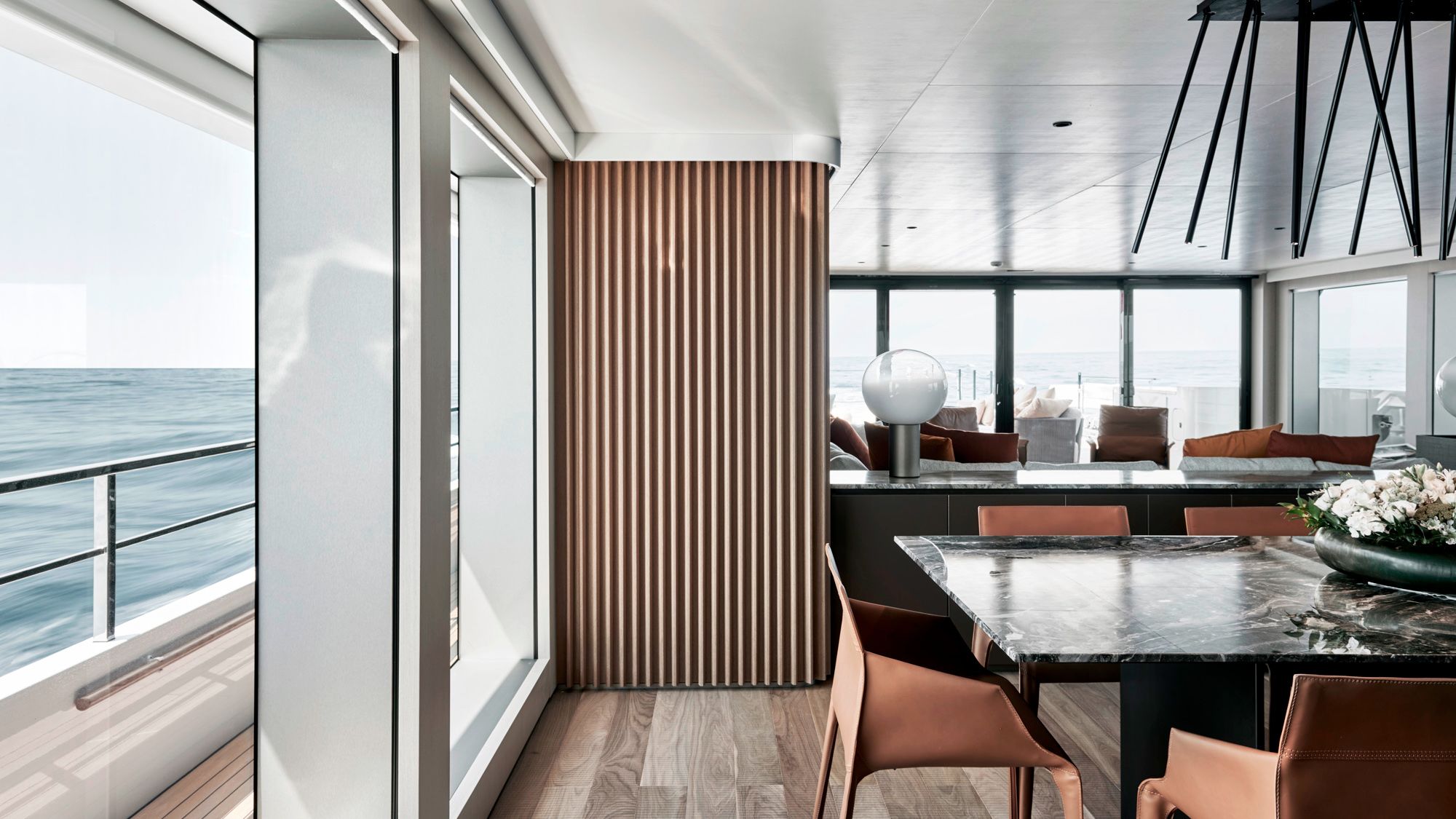
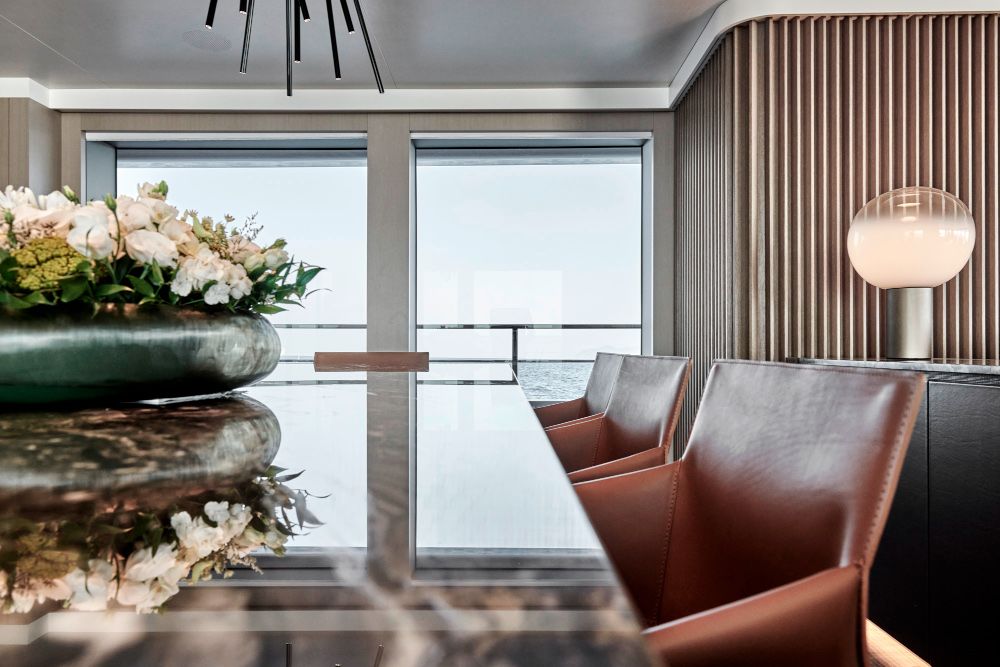

LEO TORRI
LEO TORRI

LEO TORRI
LEO TORRI
Ribbed wooden panelling on the walls combine with metal accents and tan leather to create a clubby vibe
Conventionally enough, the owner’s suite dominates the forward part of the main deck, with a cabin that runs the full 8.7-metre beam of the boat. The same ribbed panelling appears here alongside embossed cream leather on the bulkhead behind the bed and a rich chocolate leather bedhead that curves protectively around the two nightstands.
Natural light is abundant, but indirect lighting has also been carefully deployed to add depth and warmth, emphasising the pocked leatherwork. As the main deck lies below the high bow, there is no forward view. Instead, a shallow bathroom runs the full width of the forward bulkhead, with a glass-sided shower dividing the space into his and hers.
Three doubles and one twin guest cabin are arranged on the lower deck. Styling relies on a similar palette of natural materials, but departs from the main deck with a bold flash of orange leather for the bedheads. Simple panels of light wood veneer maximise the natural light, while the bathrooms use a lighter shade of marble known as grigio orobico.
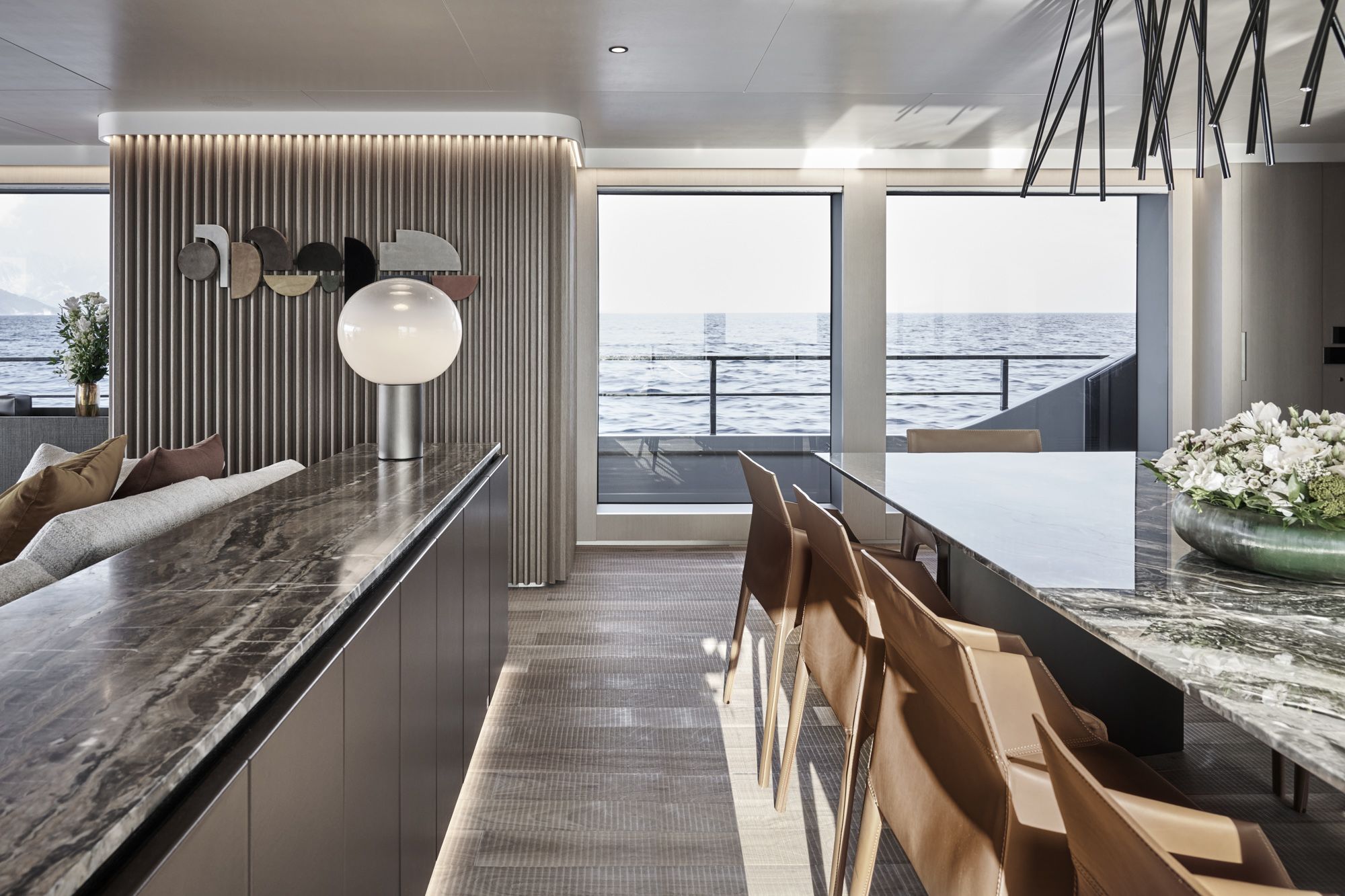
LEO TORRI
LEO TORRI
Farca also chose the art for the boat, but this wasn’t certain until the end of the project. “We designed several sculptural features, thinking we were not going to be part of the artwork project,” says Farca. “We wanted the spaces to have built-in special features that your eyes were drawn to. For example, the metal mesh in the main saloon, the shagreen staircase, the onyx niche on the upper deck or the Tetris-like assembled bars on the sundeck.”
One of the most intriguing aspects of this project is that the pandemic prevented the key players from meeting until the build was well underway. Farca’s multinational team in particular were unable to get a measure of the physical dimensions of the yacht.
“Attitude ended up having several meanings for all of the team members,” Farca remembers. “Always the key to successfully move forward with the project was the attitude with which we approached things.”
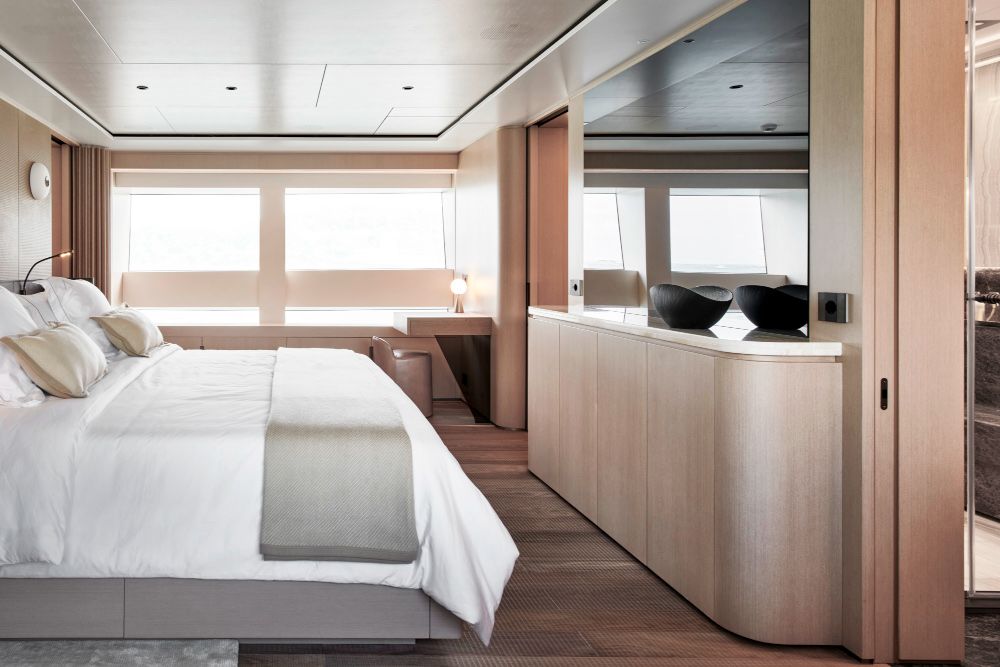
LEO TORRI
LEO TORRI
Natural light is abundant, but indirect lighting has also been carefully deployed to add depth and warmth
Baglietto has also embraced a sensible attitude when it comes to powering the yacht. With her twin Caterpillar C32 diesels running flat out at 2.4MW, Attitude can manage a top speed of 17 knots. But at a leisurely seven knots, she has a 6,900 nautical-mile range. “For sure it is not easy to combine both huge range and performance, but owners like to have both options as this allows a more flexible use of the yacht,” says project manager Carlo Toracca. “We did tank tests on the first of the line, the DOM 123 Run Away, at the Brodarski Institute in Zagreb.”
The engine room has also been designed to accommodate a full hybrid propulsion package, which will appear in a forthcoming boat. Here, the lithium battery bank powers twin 100kW motors that allow the boat to run at five knots for up to four hours – more than enough to creep silently away from a port or find a new anchorage.
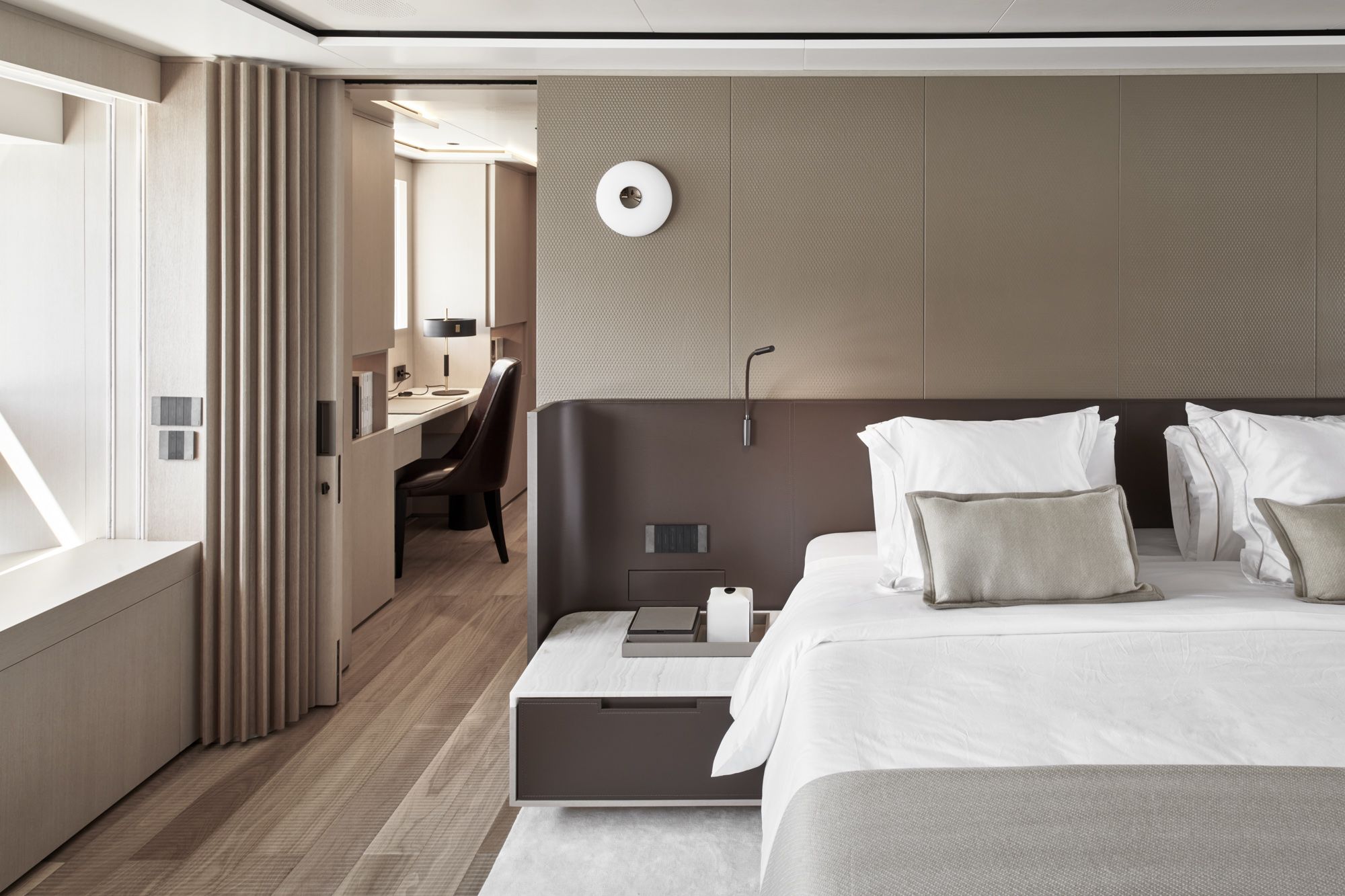
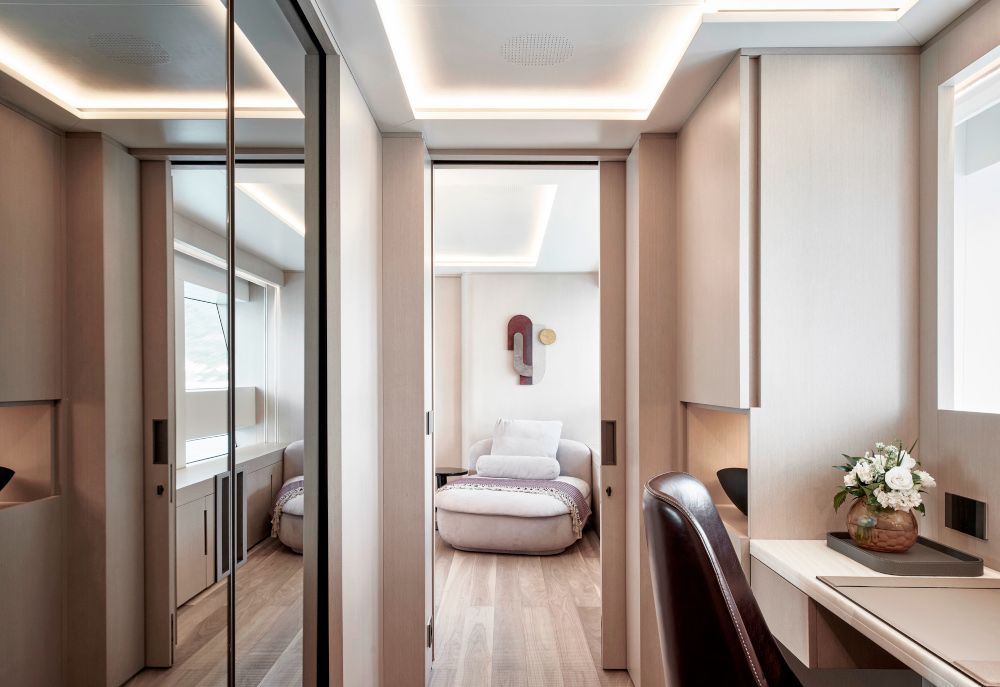

LEO TORRI
LEO TORRI

LEO TORRI
LEO TORRI
Embossed cream leather on the bulkhead behind the bed and a rich chocolate leather bedhead curve protectively around the two nightstands; the bathrooms use a shade of marble known as grigio orobico; simple panels of light wood veneer maximise the natural light
The 120kW generators can be used at optimum efficiency to drive the boat’s motors, or they can boost the traditional diesel engines. An untroubled night without the gensets is also possible, with the batteries covering at least 10 hours of hotel load. It is all part of a future-proofing strategy which would even be compatible with the Bzero hydrogen drive currently under development at Baglietto.
And it seems to be a strategy that is paying off, with seven boats sold more or less blind. Baglietto’s formula of flexible propulsion, flexible accommodation and flexible styling is clearly proving attractive. The domus moniker, with its connotations of security, homeliness and comfort, seems to be spot on. Intriguingly, the word also contains the notion of a household or family. No wonder, then, that the first owner of this new line is hoping that Attitude will form the backdrop to his children growing up. As Baglietto itself says, the DOM 133 is all about “the art of living”.
First published in BOAT International. Get this magazine sent straight to your door, or subscribe and never miss an issue.

